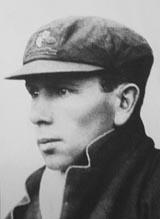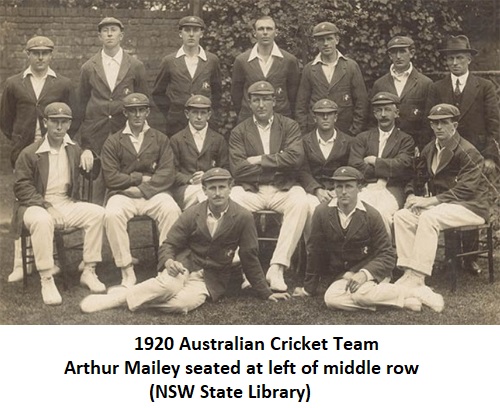
MAILEY, Arthur (1886-1967)
 An Australian representative cricketer known as “the
man who perfected the art of leg spin.”
An Australian representative cricketer known as “the
man who perfected the art of leg spin.”
Alfred Arthur Mailey,
cricketer, cartoonist and journalist, always known as ‘Arthur’, was born on 3
January, 1886, at Zetland, South Sydney, the son of John Hamilton Mailey and his
wife, Jane Charlotte, nee White. John and
Jane married in Sydney in 1875 and had eight children – William John
(1876-1960), Alice J M (1878-1954), Annabella Mary (1880-1880), Walter Hugh
(1881-1939), Alma A (1883-), Alfred Arthur (1886-1967), Henry C (1888-1916),
Stephen B (1890-1892).
At
13, Arthur left Waterloo Public School and, at first, worked selling newspapers
and as a trouser presser. At 16, he became
a glassblower which helped to strengthen his lungs and fingers. This would later
help him as a cricketer when he didn’t know what it was to have tired or sore
fingers. He later worked for the
Metropolitan Water & Sewerage Works as a repairman. On 5 May, 1913,
at St.Philip’s, Church Hill, Sydney, Arthur Mailey married Maude Gladys
Hinchcliffe, the daughter of Edward Hinchcliffe and his wife, Harriett nee Duke.
As a boy, Mailey practised and mastered the trick of bowling the ‘wrong
un’ and, after a few seasons in lower grades, made his first–class debut with
Redfern in 1912 and later joined the Balmain club where he became the
first-grade captain. When war broke
out, he tried to enlist in the army, like his brother Henry, but was rejected.
Henry was killed in Belgium in 1916.
Concentrating on his cricket, in the 1915-16 season, Mailey took 102
wickets in 13 matches leading Balmain to win their first premiership.
He later played for Waverley, Manly and Middle Harbour Clubs.
He played for New South Wales in the Sheffield Shield competition between
1912 and 1930.
Mailey, a right-arm batsman, is regarded as one of the greatest
right-arm, leg-spin bowlers. He made his
Test debut playing against England on 17-22 December 1920 at the Sydney Cricket
Ground (SCG)and his last Test on 14 August 1926 also against England at The Oval
in London. Between 1920 and 1926, he
played 21 Tests for Australia, taking 99 wickets at an average of 33.9 runs.
In the 1920-21 Ashes series, in the second innings of the fourth Test in
Melbourne, he took 9 wickets for 121 runs in 47 overs, which is still a record
for an Australian bowler. He took 10
wickets in 2 Tests and 16 times in first-class matches.
He also holds the record for the most expensive bowling analysis in
first-class cricket. In the 1926-27 season
playing against New South Wales, Victoria scored a record first-class total of
1107 runs. Mailey bowled 64 eight-ball
overs, no maidens and took 4 for 362. In
later years, Don Bradman recalled ‘Someone dubbed him the man who bowled
like a millionaire……Arthur’s objective was to take wickets and the spending of
runs in the process bothered him little’.

A gifted artist, Mailey attended J S Watkin’s art classes in Sydney.
He became a professional cartoonist and worked as a journalist and
cricket reporter for newspapers like the Sydney Sun, Daily Telegraph and the
London Bystander. Between 1920 and 1953, he published a number of booklets of
anecdotes and cartoons of cricketers of his time.
He covered the ‘bodyline’ tour in 1932-33 and wrote
’And then came Larwood’ published in
London in 1933. His 1958
autobiography was titled ’10 for 66 and
All That’ being a reference to
the humorous book of English history ‘1066
and All That’. It also referred
to a first-class game against the
Gloucesteshire County side during the 1921 tour.
In that game, Mailey took all 10 wickets for 66 runs in the second
innings. In later years, Mailey frequently
visited England, South Africa and New Zealand with Australian teams and
organized touring teams in Australia and a successful official Australian tour
of North America in 1932.
After the death of his wife, Maude, in 1938, Arthur Mailey moved to
Woolooware Road, Burraneer Bay in the Sutherland Shire where he lived with his
sons, Norman and Walter. His brother, William, lived nearby and for many years
the Mailey family ran a mixed business in Woolooware Road.
He enjoyed writing, sketching, painting in oils and water colours,
fishing and golf.
Quiet and unassuming, Mailey was one of cricket’s most lovable characters
always encouraging the young and hopeful to ‘have a go’, have fun and not take
themselves or statistics too seriously. His kindness and humility endeared him
to many and, on his death, many heartfelt tributes were recorded by those
fortunate to have known him. As a
young man, he once took the wicket of his hero, the legendary Victor Trumper.
Rather than celebrating it as a triumph, he said ‘As I watched the receding figure, I felt like a boy who had killed a
dove’.
Arthur Mailey died at Kirrawee on 31 December, 1967, three days before
his 82nd birthday. He was
cremated at Woronora Cemetery with Anglican rites.
View the entry in the
database for MAILEY, Arthur (1886-1967) and
family Click on his name at the heading of this
page.
References:
Re
Australian Dictionary of Biography
Wikipedia
Australian Cricket
– Jack Pollard
NSW BDM
A king without a crown
– J C Robertson
Trove
Sydney Morning Herald
The Sun
Daily Telegraph
NSW Electoral Rolls
Australia Cricket/ Cricket Players and Officials



